Mexican Wedding Traditions
MexicanWedding Traditions
MexicanWedding Traditions
Traditions
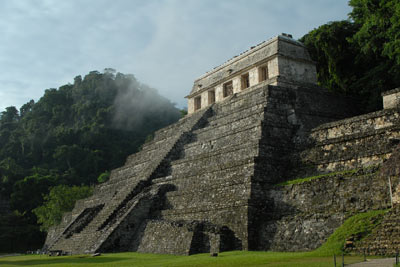
Many Mexican Americans desire a wedding which reflects their native heritage. You must understand where ancestors may have originated from to plan the wedding reflecting your heritage.We have included many traditions from Mexico. Please feel free to contact us with your comments, pictures, and any other traditions which you would like us to include. Enjoy!
One of the traditional aspects of any Mexican wedding is recognizing the fact that a majority of Mexicans are Catholic, with a deeply rooted faith. Thus, the church is going to play a critical role in your Mexican wedding to reflect the spirituality and sacredness of the occasion. There are multiple symbols and customs incorporating the church and various spiritual aspects that are significant to the couple’s new life.
From a reader: Dear Linda,
I was so pleased while reading through your wonderful collection of information about hosting a traditional Mexican wedding. You have all the details just right, and I really appreciate all the time you put into making this such a good resource. Your mention of the prayer over the bride brought back memories of my own wedding!
I thought, with your interest in Mexican culture, you might like to see the traditional Mexican dress I recently sewed and embroidered. These beautiful garments have existed since the 1600’s and each one tells a special story. Would my website be of use to you as a further resource for your readers? .
My heritage is, in part, Hispanic, and I have always loved the beautiful, traditional clothing of Mexico. My family owns an heirloom dress from Oaxaca, but it is a little time-worn, and so I studied it and made myself a set of instructions from which I could recreate my own Mexican dress. It turned out to be so easy (made out of just 5 rectangles!) I thought I could share what I’d learned with others, and I’d be so pleased if you would take a look at what I’ve done and see if this could be a help to your readers.
The Mexican wedding shirt has been around for the past 200 years. This shirt has a loose style, and, as a result, it can be worn by all shapes and sizes. These crisp, cool shirts are fresh, light, and flattering to any body shape.
The origin of the name came from a legend, which tells about a poor country wife that would sew large pockets in her husbands’ shirt for him to carry guava fruit home, thus giving it the name guayabera (guava = guayaba in Spanish ). Some say the shirt originated in Cuba and others swear it was in Mexico. Traditional linen guayaberas are still the most popular beach wedding shirts because of their comfort, style, and freshness.
Food & Music
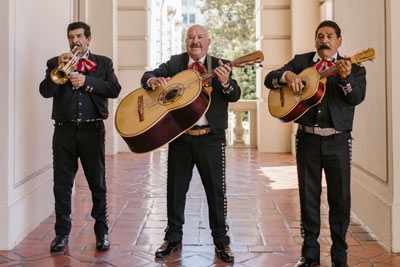
Traditional foods include spicy rice, beans, tortilla dishes, using chicken and beef. Sangria is served. It is a cold drink made from red or white wine mixed with brandy, sugar, fruit juice and soda water. Salsa, merengue and the flamenco guitar music add a Latin flare to the reception.
Mariachi music consists of trumpets, drums, guitars, as well as harps and violins. The men wear black suits, their pants laced with silver. They may also dress in white. Music from the Veracruz region is played with more delicacy.
Musicians from northern Mexico dress in blue satin, with white frills and wear cowboy boots. Their music has a distinct staccato beat. Although the snare drum leads, accordion sounds will also be heard.
Major Religious Beliefs
The major religious faith found in Mexico is Roman Catholic. Some of the customs of a Mexican wedding originated after the Spanish came to Mexico and intermarried with the native Aztec Indians, blending their religion with some of the Aztec customs of worship.
The Catholic Church went along with this because it was more acceptable for the Aztecs to want to call themselves “Christians” if the church would allow them to bring some of they’re own more familiar methods of worship into the church.
Today in parts of New Mexico (United States), wedding customs are mixed with Catholic/Aztec origins. About 40% of the Mexican people are traditionally Roman Catholics. The wedding service would follow the rules of the Catholic church and is usually a full Mass.
Wedding Invitations
The wedding invitations should also include information about the time and date of the wedding, as well as the church where the ceremony will be held.
If a complete list is not included as a part of the invitation, a separate sheet listing the bridal party and sponsors is included.
Many Mexican weddings have sponsors, which are the equivalent of godparents for the married couple. They are chosen because of their special relationship with the couple. These individuals will have important responsibilities with the wedding, perhaps paying for certain parts of the celebration and will be included in the wedding rituals. A sponsor might be assigned to a specific duty, such as wrapping the wedding lasso or carrying arras during the ceremony. They also might walk down the aisle after the couple’s parents as part of the procession.
Wedding Traditions
In some cities of northern Mexico, there is the tradition of giving a ring called “of promise” that occurs before the ring of commitment, sometimes up to a year before giving the one of commitment. It is made generally in the long engagements, which are common in my area [pais]. This tradition was shared with us by Cecilia Herrera
“Sponsors” are usually godparents or special others who contribute to the cost of the wedding. In establishing the wedding budget, and particularly in contracting for wedding services, it is important to know which sponsors may be paying for what part of the wedding.
Prior to leaving the home for the ceremony, the bride’s mother (or parents) offers a prayer with the bride.
Mariachis may replace organ music but the bride’s march is usually played on the organ.
Mexican weddings tend to be large with many attendants. The attendants are called madrinas and padrinos and they have special roles in the wedding.
The flower girl and ring bearer are dressed as miniature versions of the bride and groom. The madrina de ramo carries flowers for the Virgin Mary. The madrina de laso carries a jeweled or beaded rope that is placed around the couple as they say their vows, to symbolize their union.
The Thirteen Gold Coins (Trece monedas de oro)
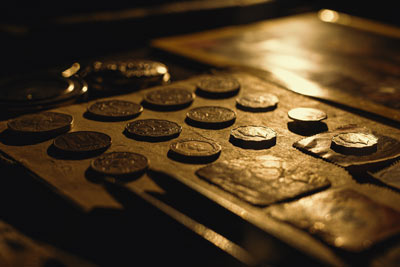
The madrina de arras holds the 13 coins the bridegroom presents to the bride. The a coin, or arrhea, was a Roman custom of breaking gold or silver, one half to be kept by the woman and the other half by the man, as a pledge of marriage.
The groom gives the bride thirteen gold coins as a symbol of his unquestionable trust and confidence. He pledges that he places all of his goods into her care and safekeeping. Acceptance by the bride means taking that trust and confidence unconditionally with total dedication and prudence.
The custom of the coins originated in Spain. Thirteen gold coins (arras) are given to the bride by the bridegroom, signifying he will support her. Often presented in ornate boxes or gift trays, this represents the bride’s dowry and holds good wishes for prosperity. These coins become a part of their family heirloom.
The number 12 represents Christ and his 12 apostles. The coins are presented to the priest by a friend or relative (usually the purchaser). The priest then blesses the coins and hands them to the bride who places them in the groom’s cupped hands at the beginning of the ceremony. The coins are then placed on a tray and handed to an assistant to be held until later in the ceremony. Near the end of the ceremony, the box and coins are given to the priest who places the coins in the box and hands them to the groom.
The groom will then pour the coins into the bride’s cupped hands and places the box on top. This represents his giving her control as his mistress of all his worldly goods. (Sometimes their hands are tied with a ribbon for this portion of the ceremony.)
Other Participants
The madrina de copas carry the wine glasses for the toast. Madrinas or padrinos carry a prayer book, a rosary, a guestbook for signatures and an embroidered pillow to commemorate the day.
There also is a madrina de velacion, who the bride has chosen to turn to for guidance throughout her married life. Godparents of the bride and bridegroom give the couple a prayer book, rosary, and kneeling pillow for the ceremony.
The last persons in the procession carry the recuerdos, which are remembrances given to the guests. In addition, there can be several sets of wedding sponsors, similar to godparents, who look after the couple promising them financial and spiritual aid.
The Sign of the Cross (Muestra de la cruz)
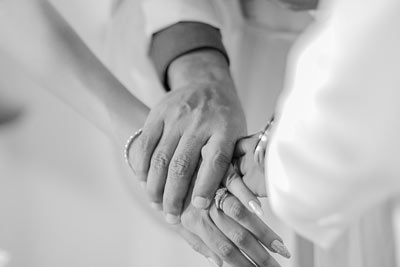
The priest makes the sign of the cross over the groom’s head. The groom kisses the cross. The bride kisses the cross. (This represents the swearing of faithfulness to one another.)
The sign of the cross is a simple gesture that has been made by Catholics for hundreds of years. It is a multifaceted symbol, a confession of faith, a renewal of baptism, and a mark of discipleship. The sign of the cross is also used to demonstrate that the couple are dedicating themselves to following Jesus within their relationship. As the cross is a symbol at baptism, it also can be seen as demonstrating a couple’s commitment to each other spiritually.
At the beginning of the ceremony, the priest will greet the guests and invite them to sing an opening hymn. Then the priest will offer an opening prayer. After the procession of the wedding party, the Liturgy of the Word, several readings that are recited by friends, family members, or the priest. Once those readings are complete, the priest may offer a homily, reflecting on the messages to be found in those readings and the sanctity of marriage itself.
The rings will also be blessed by the priest, as they are symbols of love and fidelity. Once the spouses exchange rings, the ceremony will include the exchange of las arras matrimoniales.
Couples can also choose to partake in the nuptial mass. Special family members can also be chosen in advance to assist in the offertory, or presentation of gifts of bread and wine to the priest who performed the wedding ceremony.
The Lasso (El lazo)
As part of the wedding celebration, there is the money dance. While the specific origin of this dance is not known, they have become part of wishing the couple luck in their marriage. Guests at the wedding reception will have bills ready to pin on the couple, exchanging them for a dance. However, the couples and their families can get creative about how those bills are collected. Some might have the bills thrown on the floor, while others have a designated individual in charge of collecting the cash.
Although there is a traditional wedding reception, many couples can choose to have a La Tornaboda or wedding after-party. This is when the couple gathers with close family and friends after the larger wedding reception. Wedding receptions tend to be an open invitation to everyone so they can come, eat, and dance. That can mean the reception could have hundreds in attendance. La Tornaboda allows couples to have a more intimate celebration with those who are close to them.
As part of the ceremony to symbolize unity, a large loop of rosary beads or a lasso (cord) is placed in a figure eight shape around the necks of the couple after they have exchanged their vows. It also is beautiful when made of entwined orange blossoms (which symbolize fertility and happiness). A double rosary lasso may also be given by one set of the parents and may be blessed with holy water three times in honor of the Trinity.
A special person/couple places the lasso around the shoulders of the bride and groom, groom’s shoulder’s first. The lasso may also be tied around their wrists. The couple wears the lasso throughout the remainder of the service. (The loop is symbolic of their love which should bind the couple together every day as they equally share the responsibility of marriage for the rest of their lives.)
At the end of the ceremony, the lasso is removed by either the couple which placed the lasso on the couple or the priest. The lasso is given to the Bride as a memento of her becoming the mistress of the groom’s heart and home.
Most weddings will use the mariachis at the end of the ceremony as part of the recessional.
The reception is always family oriented and festive. Everyone is presumed to be invited.
For the bridal couple’s first dance, guests will gather in a heart-shaped ring at the reception around the couple. Salsa, merengue and the flamenco guitar music may add a Latin flare to the reception.
Favors could be wedding cookies wrapped in tulle, Spanish fans, note cards of Mexican painters, or pieces of pottery could be given.
Wedding Traditions
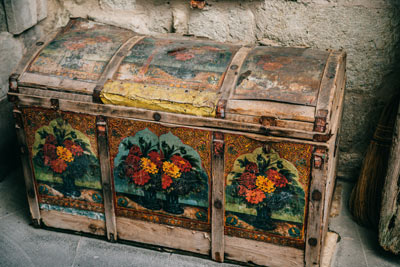
In ancient times, weddings were held in the bride’s yard or house. The groom traveled by horse to the bride’s house and after the wedding ceremony took his wife in a palanquin (cart) to his parents’ house to live. The bride and groom wore formal court costumes for the wedding ceremony. Ordinary people were permitted to wear luxurious clothes only on their wedding day. Hand lanterns are used for lighting the way from the groom’s home to the bride’s home on the night before the wedding. Traditionally, the groom’s family would carry a wedding chest filled with gifts for the bride’s family.
Wedding ducks are a symbol for a long and happy marriage. Cranes are a symbol of long life and may be represented on the woman’s sash.
In larger cities, luxury hotels will have ‘wedding rooms‘used specifically for wedding ceremonies. These rooms are decorated with a wedding motif and rented to couples.
Planning
Planning a wedding is a family affair in Mexico, and the role of mentors and sponsors has historically been crucial. Sponsors or “padrinos” are selected by the couple. They are often grandparents, parents, godparents or other relatives. This role is considered an honor.
Sponsors may perform several roles, including serving as a role model for the type of couple the betrothed aspire to be or to provide financial support for the couple. Role model sponsors generally serve as the witness to the marriage. Gift-giving sponsors may pay for a certain aspect of the wedding (flowers, photography, catering), and would, therefore, have much input on that aspect during the planning.
In modern Mexican weddings, sponsorship is often more of an honorary role without financial requirements, as many brides and grooms have opted for a greater say in the planning process.
Planning a modern Mexican wedding often requires choices to be made about the following elements:
- The Bride’s attire, including the dress veil, shoes, makeup, and hair
- The Groom’s attire
- The bridal party – who to include, their assigned tasks for the day, and their attire
- The ceremony itself (if religious, it may include additional traditions)
- Photography
- Catering
- Decorations
- Entertainment/music
- Cakes/desserts
Mementos for guests (favors)
Checklists
Due to the heavy planning that is required to hold a wedding in Mexico (or anywhere), it is a good idea to consider developing a checklist to keep you on task. If you also include a timeline, it will help you to stay even more organized. An example wedding checklist may include items such as:
1 Year Prior
- Set the date
- Select sponsors
- Make a wedding announcement
- Plan for and hold an engagement party
- Identify a budget
- Begin working on a guest lest
- Reserve a place for the ceremony and reception
- Select members of the bridal party
6-9 Months Prior
- Select wedding dress and accessories
- Identify the attire for the bridal party
- Select the groom’s attire
- Book a caterer
- Select a florist/flowers
- Book a musician/DJ/mariachis
- Select a photographer/videographer
- Plan the rehearsal dinner
- Finalize the guest list
- Order invitations
- Begin working on/ordering favors
- Develop a registry
- Purchase wedding rings
- Plan a honeymoon
4-6 Months Prior
- Mail invitations
- Finalize details for catering
- Write vows
- Plan and hold the bridal showers
- Schedule the rehearsal dinner
- Research marriage license requirements
One Month Prior
- Pickup dresses and other attire for final fittings
- Obtain a marriage license
- Make transportation arrangements
- Confirm all reservations
One Week Prior
- Pack for honeymoon
- Confirm the responsibilities of all parties
- Write vows
- Review all the details
Day Before
- Rehearse ceremony
- Hand out bridal party gifts
- Hold rehearsal dinner
Tips
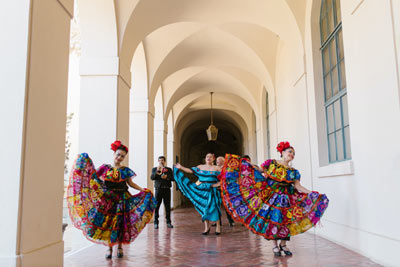
Modern Mexican weddings are often a blend of beautiful historical traditions with modern norms – and each couple will select their unique blend of both. Given this, there are some helpful things to know if you are planning or attending a Mexican wedding.
- Wedding coins, or las arras matrimoniales, are a common and long-standing tradition. The arras are 13 coins that are given to the bride from the groom to symbolize his trust in her.
- La tornaboda, or afterparty, is frequently arranged for close family and friends. It occurs after the main reception and allows the couple to celebrate more intimately with their closest friends and family.
- El lazo, or the wedding lasso, is common in Catholic weddings held in Mexico. It is a string of flowers or rosary beads that is placed around the couple as the officiant blesses the couple’s marriage. They will wear this until mass concludes and the priest removes it.
- Many weddings have contemporary musicians or DJs during the reception, but some will also incorporate mariachi for part of or all of the ceremony. Mariachi is a style of music authentic to Mexico.
Dresses
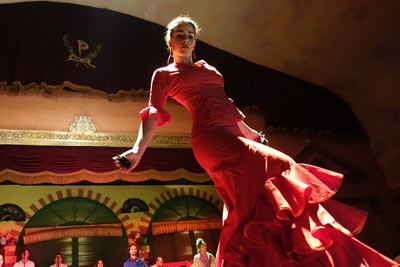
The Bride may wear a mantilla veil, or a slim dress with a bolero jacket, or even a Flamenco-style dress with ruffles at the hem. In lieu of carrying flowers she may carry a fan. The groom may choose to wear a matadorian outfit – a bolero jacket with tight-fitting pants, or, a Mexican wedding shirt with loose, drawstring pants.
The mantilla on the left is the classic Spanish look, in the traditional chapel length with intricate lace detail throughout.
Mexican wedding dresses come in various styles, designs, and materials, so you do not have to feel limited to just a few options. It is expected that your Mexican wedding dress will be beige or white and include a dress tail and veil, but the rest of your Mexican style wedding dress is up to you. The Mexican Huipil wedding dress, for instance, is made from 100% cotton and a full-length dress. Another option is the Huasteco wedding dress that is strapless with embroidery in the chest and quexquemitl at the waist, giving it a unique flair.
Other options are fitted at the waist before flaring out at the knees, often decorated with flowers or ruffles. Mexican wedding dresses offer options to make you feel beautiful on this sacred and special day.
Food and Music
Traditional foods include spicy rice, beans, tortilla dishes, using chicken and beef. Sangria is served. It is a cold drink made from red or white wine mixed with brandy, sugar, fruit juice and soda water. Salsa, merengue and the flamenco guitar music add a Latin flare to the reception.
Mariachis play during the Mass, which is part of the wedding ceremony. The church can be decorated with flowers and other colorful decorations, but the primary focus is on God and the Blessed Mother Mary can guide the couple through their new life as a married couple and later as they have children, thus adding to their family. With the sacredness of the event being the focus, your Mexican style wedding dress needs to reflect the spiritual and solemn nature of the event. The whole event is expected to take about a hour, which reflects the length of a typical Mass.
Mariachi music consists of trumpets, drums, guitars, as well as harps and violins. The men wear black suits, their pants laced with silver. They may also dress in white. Music from the Veracruz region is played with more delicacy.
Musicians from northern Mexico dress in blue satin, with white frills and wear cowboy boots. Their music has a distinct staccato beat. Although the snare drum leads, accordion sounds will also be heard.
Major Religious Beliefs
The major religious faith found in Mexico is Roman Catholic. Some of the customs of a Mexican wedding originated after the Spanish came to Mexico and intermarried with the native Aztec Indians, blending their religion with some of the Aztec customs of worship.
The Catholic Church went along with this because it was more acceptable for the Aztecs to want to call themselves “Christians” if the church would allow them to bring some of they’re own more familiar methods of worship into the church.
Today in parts of New Mexico (United States), wedding customs are mixed with Catholic/Aztec origins. About 40% of the Mexican people are traditionally Roman Catholics. The wedding service would follow the rules of the Catholic Church and is usually a full Mass.
Getting approved for a Catholic wedding involves submitting specific documents, participating in various church activities, intensive marriage counseling and preparation with a priest, and becoming familiar with the Church’s teachings on marriage. To get married in a Catholic church is not a quit process but can take up to six months to complete all the requirements. Other priests suggest that couples put anywhere from nine months to a year aside for marriage prep with their local Church before choosing a date. The point of this preparation is to help the couple discuss specific areas of their lives, including various beliefs and values that will impact their decisions as a couple. There are also canonical and legal aspects necessary for the Church to complete.
Part of this process is also recognizing that your wedding ceremony can only be administered in the Church, since it is seen as sacred and also emphasizes the sanctity of the marriage itself. To incorporate outdoor components into your wedding day, you might have to wait until the reception. Also, Mexican Catholic weddings do not allow you to personalize your vows. The vows are seen as making the marriage, so they are very specific regarding what words can be used and how they must be said.
Cakes
Unlike wedding cakes in the US, Mexican wedding cakes are not one giant, multi-tiered cake. In fact, there are often multiple cakes – although the best of these are featured on the grand cake table. Cake types often include tres leches cake or other types of fruitcake. There are often many choices of large, grand cakes, along with other sweet treats, including “Mexican wedding cakes,” which are not a cake at all, but a cookie, also known as polvorones.
 Tres Leches Cake :
Tres Leches Cake :
A cut of Tres Leches cake with strawberries to finish everything.
This wet, drain based wipe cake is generally from Mexico, despite the fact that it has turned into an extremely well-known cake all over South America. The base of the dish is a margarine wipe cake that will later be absorbed three sorts of drain, dense, vanished and standard. More often than not, it is finished with whipped cream or Meringue. The blend is an exceptionally damp and rich cake, with an altogether different taste from common wipe cakes.
Resources and References
Special thanks to Lois Pearce, Master Bridal Consultant of Hamden, Connecticut, for her time and energy gathering the majority of information used here. We also wish to thank the Association of Bridal Consultants for their assistance.
Please note that the information contained in this category should be considered general in nature. We believe it to be a true and accurate representation of some of the customs and traditions for this country or religion. Information provided by individuals and organizations is assumed to be correct.
You are welcome to email us at join@weddingdetails.com with any suggestions for changes, additions or deletions.
Avalon, Classic Thermographers, Wedding Stationers Latin America, Robert T. Buckman, The World Today Series, Stryker-Post Publication, 1997
Mimi Doke, Master Bridal Consultant
Teddy Lenderman, Master Bridal Consultant
Renee Ramirez
Cecilia Herrera
Giftware News, November 1993, June 1995

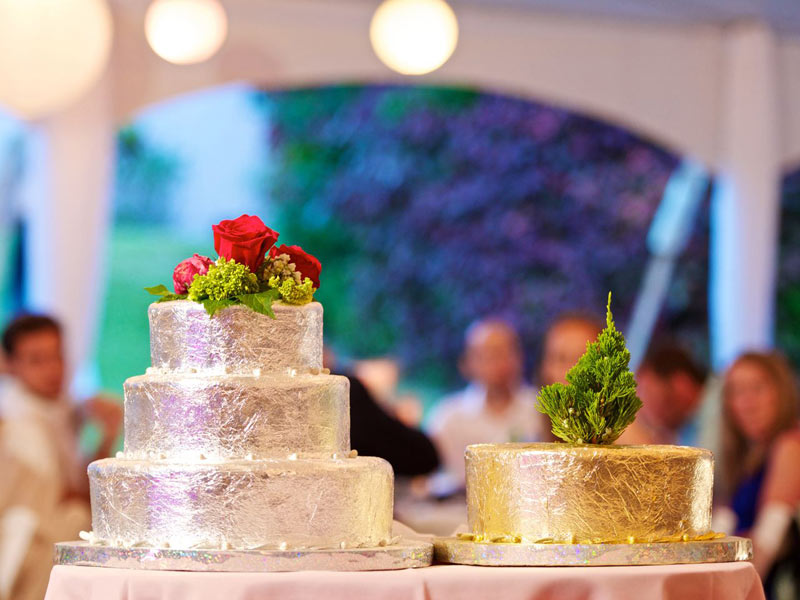 Tres Leches Cake :
Tres Leches Cake :